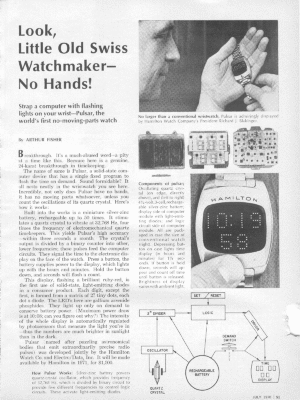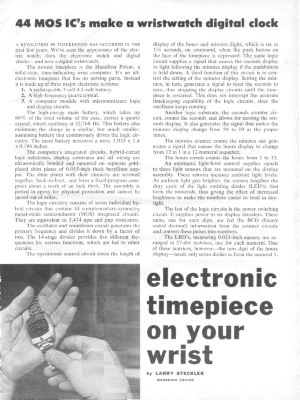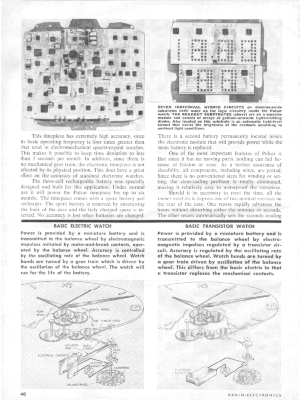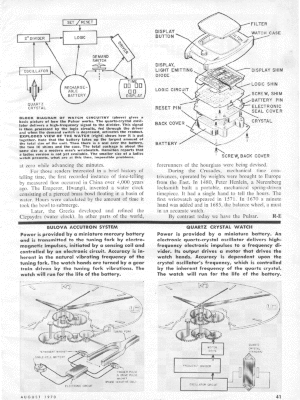|
[This article appeared in the August 1970 issue of Radio-Electronics magazine.]
Electronic timepiece on your wrist
44 MOS IC's make a wristwatch digital
By Larry Steckler, Managing Editor
A revolution in timekeeping has occurred in the past few years. We've seen
the appearance of the electric watch; then the electronic watch and digital
clocks - and now a digital wristwatch.
The newest timepiece is the Hamilton Pulsar, a solid-state, time-indicating
wrist computer. It's an all-electronic timepiece that has no moving parts.
Instead, it is made up of three major electronic sections:
- A rechargeable 3-cell 4.5-volt battery
- A high-frequency quartz crystal
- A computer module with microminiature logic and display circuits
The high-energy main battery, which takes up 80% of the total volume of the case,
excites a quartz crystal, which oscillates at 32,768 Hz. This battery also
maintains the charge in a similar, but much smaller, sustaining battery that
continuously drives the logic circuitry. The main battery measures a mere
1.035 x 1.4 x 0.196 inches.
The computer's integrated circuits, hybrid-circuit logic substrates, display
substrates and all wiring are ultrasonically bonded and mounted on separate
gold-plated shims plates of 0.015-inch thick beryllium copper. The shim
plates with their circuitry are screwed together, back-to-back, and form a
fixed-program computer about a tenth of an inch thick. The assembly is
potted in epoxy for physical protection and cannot be jarred out of order.
The logic circuitry consists of seven individual hybrid circuits that contain
44 complementary-symmetry metal-oxide semiconductor (MOS) integrated circuits.
They are equivalent to 3,474 npn and pnp transistors.
The oscillator and countdown circuit generates the primary frequency and
divides it down by a factor of two. The 14-stage divider provides five
different frequencies for various functions, which are fed to other circuits.
The operational control circuit times the length of display of the hours and
minutes digits, which is set at 1 1/4 seconds, on command, when the push
button on the face of the timepiece is depressed. The same logic circuit
supplies a signal that causes the seconds display to light following the
minutes display if the pushbutton is held down. A third function of this
circuit is to control the setting of the minutes display. Setting the
minutes, in turn, generates a signal to reset the seconds to zero, thus
stopping the display circuits until the timepiece is restarted. This does not
interrupt the accurate timekeeping capability of the logic circuits, since
the oscillator keeps running.
Another logic substrate, the seconds counter circuit, counts the seconds and
allows for zeroing the seconds display. It also generates the signal that makes
the minutes display change from 59 to 00 at the proper times.
The minutes counter counts the minutes and generates a signal that causes the
hours display to change from 12 to 1 in a 12-numeral sequence.
The hours circuit counts the hours from 1 to 12.
An automatic light-level control supplies signals to three light sensors that
are mounted on the display assembly. These sensors measure ambient light levels.
As ambient light gets brighter, the sensors lengthen the duty cycle of the light
emitting diodes (LED's) that form the numerals, this giving the effect of increased
brightness to make the numbers easier to read in daylight.
The last of the logic circuits is the power switching circuit. It supplies power
to six display decoders. These units, one for each digit, are fed the BCD
(binary coded decimal) information from the counter circuits and convert these
pulses into numbers.
The LED's, measuring 0.021-inch square, are arranged in 27-dot matrices, one for
each numeral. One of these matrices, however - the tens digit of the hours display - needs
only seven diodes to form the numeral 1.
This timepiece has extremely high accuracy, since its basic operating frequency is
four times greater than that used in electromechanical quartz-crystal watches.
This makes it possible to keep time deviation to less than 3 seconds per month.
In addition, since there is no mechanical gear train, the electronic timepiece is not
affected by its physical position. This does have a great effect on the accuracy
of standard electronic watches.
The three-cell rechargeable battery was specifically designed and built for this
application. Under normal use it will power the Pulsar timepiece for up to six
months. The timepiece comes with a spare battery and recharger. The spent battery
is removed by unscrewing the back of the case and the fully charged spare is
inserted. No accuracy is lost when batteries are changed.
There is a second battery permanently located inside the electronic module that
will provide power while the main battery is replaced.
One of the most important features of the Pulsar is that since it has no moving
parts, nothing can fail because of friction or wear. As a further assurance of
durability, all components, including wires, are potted. Since there is no
conventional stem for winding or setting, the stem-sealing problem is totally
eliminated, making it relatively easy to waterproof the timepiece.
Should it be necessary to set the time, all the owner needs to do is depress one
of the two marked recesses on the rear of the case. One recess rapidly advances
the hours without disturbing either the minutes or the seconds. The other recess
automatically sets the seconds reading at zero while advancing the minutes.
For those interested in a brief history of telling time, the first recorded
instance of time-telling by measured flow occurred in China over 4,000 years ago.
The Emperor, Hwangti, invented a water clock consisting of a pierced brass bowl
floating in a basin of water. Hours were calculated by the amount of time it took
the bowl to submerge.
Later, the Greeks developed and refined the Clepsydra (water clock). In other
parts of the world, forerunners of the hourglass were being devised.
During the Crusades, mechanical time contrivances, operated by weights were
brought to Europe from the East. In 1480, Peter Henlein, a Nuremberg locksmith
built a portable, mechanical spring-driven timepiece. It had a single hand to
tell the hours. The first wristwatch appeared in 1571. In 1670 a minute hand
was added and in 1685, the balance wheel, a must in an accurate watch.
By contrast today we have the Pulsar.
Original Scans
| 


